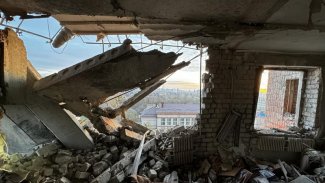The Russians strike Kharkiv city. Day 775 of the war

![]()
Russian forces extended the zone of control on the outskirts of Chasiv Yar, but were unable to penetrate deep into the so-called Kanal microdistrict, the part of the town which lies east of the Donetsk-Donbas canal. Instead, they pushed the Ukrainian defenders out of Bohdanivka, for which fighting had been ongoing since December 2023; according to some sources, the Russians entered neighbouring Kalynivka, located north of the Kanal microdistrict. The invading troops also reached the Donetsk-Donbas canal south of Chasiv Yar, from the direction of the village of Ivanivske.
The Russians made further advances west of Avdiivka, but these did not change the overall situation. Clashes are continuing for the village of Semenivka, which lies on the west bank of the Durna river. The defenders are holding onto the northern part of the village of Berdychi and the western part of Pervomaiske (which lie north and south-west of Avdiivka respectively), as well as the western part of Novomykhailivka (south of Marinka). The invaders’ repeated assaults west of Kreminna, east of Siversk and south of Orikhiv have not brought about any significant changes to the territory held.
![]()
The invaders intensified their attacks on the energy and industrial infrastructure at the rear of the frontline, with the cities of Kharkiv and Zaporizhzhia as their main targets. From 4 to 8 April, both cities and their surroundings were attacked almost daily, the former on average twice a day (three times on 5 April). In Zaporizhzhia, Russian missiles struck the Motor-Sich plant several times; according to some sources, they also hit Progress, which was an important manufacturer of aircraft components before the war. Both sites are currently servicing and repairing heavy armaments. Other targets in Kharkiv and Zaporizhzhia were drone assembly plants and warehouses, and an ammunition depot was also hit in the former city (6 April).
Between 5 and 9 April, high-voltage substations were destroyed or damaged in five oblasts: Odesa, Kharkiv, Dnipropetrovsk, Poltava and Lviv. In Odesa oblast, Russian rockets and drones hit the port infrastructure and a ‘logistics and transport facility’ (on 6 and 8 April respectively). On 8 April, they hit a critical infrastructure facility, most likely an oil and gas terminal, near Zviahel in Zhytomyr oblast. Following the attack, the city authorities appealed to residents not to leave their homes due to possible air pollution. A total of 43 rockets and 126 Shaheds were used by the invaders between the 4th and the morning of 9 April. The defenders claimed to have shot down four rockets and 106 drones.
The attacks on Kharkiv, which intensified at the end of March, have contributed to a significant deterioration of the situation in the city. The inability to stabilise power supplies is having a negative impact not only on the residents remaining there, but above all on the potential of the defenders. Kharkiv’s defence industry – although it has largely been destroyed by the ongoing attacks over the past two years – is still operational and repairing heavy weaponry, although the persistent energy shortages make this activity much more difficult. The recent hostile strikes on Zaporizhzhia city, whose industrial base plays an analogous role to that of Kharkiv, are having a similar effect. However, Kharkiv is the key industrial centre under Ukrainian control east of the Dnieper, and is the main base for the defenders in the east. The city’s importance is evidenced by the fact that, since early April, the situation there has twice been the main topic of defence staff (named Stavka) meetings chaired by President Volodymyr Zelensky.
Kyiv’s main problem is its inability to organise an effective air defence of Kharkiv and the other major centres on the immediate frontline. In contrast to central and western Ukraine, only a small proportion of the kamikaze drones attacking them are usually destroyed, and Russian missiles are only occasionally shot down. Due to the short distance from the contact line (and from the Russian border, in the case of Kharkiv), the vast majority of missiles (mainly from the S-300 and Iskander-M systems) can hit their targets even before the air alert is sounded. The short flight paths make the work of the air defence more difficult, thus making it easier for the invaders to destroy it. The inadequate warning system also results in frequent civilian casualties.
![]()
On 5 April, Ukrainian forces carried out a massive kamikaze drone attack, with the main targets being the Russian military airfields of Morozovsk in Rostov oblast, Yeysk in Krasnodar krai and Engels in Saratov oblast. The only effects of these raids were some damage to a transformer substation in the area of Morozovsk, which most of the drones attacked (according to Russian sources, between 40 and 44 of the 53 used by the Ukrainians). Satellite images did not confirm Ukrainian media reports that at least six aircraft were destroyed and another eight damaged, together with infrastructure. It is most likely that in fact none of the drones reached the airfields. The day before, Ukrainian kamikaze drones (10 according to the Russians) struck Kursk, but caused no serious damage.
![]()
Another security agreement has been concluded. On 3 April, the presidents of Finland and Ukraine signed an agreement on security cooperation and long-term support in Kyiv. Finland pledged to provide assistance to Ukraine, particularly in the areas of security and defence. The agreement includes the allocation of a financial assistance package, Finland’s 23rd, worth €188 million. This will bring the total military support Helsinki has provided since the beginning of the invasion to nearly €2 billion. The agreement stresses that Finland “is committed to supporting Ukraine’s efforts to implement reforms on the road to future NATO membership”. Ukraine has similar agreements with the UK, Germany, France, Denmark, Italy, Canada and the Netherlands.
President Zelensky has appealed for the delivery of Patriot systems. On 6 April he stated that if the country’s air defence is to be strengthened effectively, that will require the delivery of 25 Patriot systems of 6–8 batteries each by Western countries. He stressed that the intensity of Russian air attacks (especially on Kharkiv) has increased, and if it continues at the current level, the air defence could be rendered inoperative due to the exhaustion of missile stocks.
More funding for demining has been provided. On 7 April the Ministry for the Reintegration of the Temporarily Occupied Territories of Ukraine announced that the US, Switzerland, Norway, Japan, the Netherlands and Germany had so far provided $700 million for demining (to be spent by 2027).
![]()
Ukraine is facing problems with mobilisation. On 3 April, the Central Board for the Protection of Military Rights was established within the Ministry of Defence of Ukraine. It will report directly to the head of the ministry, and will be responsible for handling requests and complaints from military personnel, providing basic legal assistance, conducting inspections and investigating violations of the rights of soldiers and their family members. The ministry stated that the irregularities which have been observed relate to shortcomings in the provision of necessary equipment to military personnel, unjustified refusals to grant leave, abuses of power by commanders violating the soldiers’ rights, insufficient care, and failure to implement public financial guarantees, including compensation payments to the families of the fallen. The ministry’s actions have been taken rather belatedly, in response to the deteriorating mood of the fighters.
On 4 April, a survey on public attitudes to mobilisation was published. It shows that 36% of Ukrainians consider the current mobilisation to be insufficient to fully restore combat potential, while 30% consider it to be optimal, meeting the needs of the army. Only 19% of respondents said that the scale of the current mobilisation is too large.
On the same day, human rights ombudsman Dmytro Lubinets criticised the practice of stopping men on the streets and handing them summonses for military service. He stressed that the government should want to recruit those who are positively motivated to serve, without the need for coercion. He indicated that he was opposed to granting the military commissions the right to detain people whose military service status was unregulated.
On 8 April Oleksandr Pavliuk, the commander of the Ukrainian Land Forces, appealed for people to join the armed forces. He announced that Russia was conducting a widespread disinformation and psychological operation to fuel panic and mistrust in the army among the Ukrainian people. He added that the defence of the state is one of the citizen’s constitutional duties, and the military authorities will not tolerate violations of the law on universal military service. He insisted that those deemed fit for service are sent to training centres, and not directly to the frontline. After basic military training, which lasts a month, recruits are assigned to units, where they acquire skills useful in combat operations. Pawluk’s dramatic statement indicates that the Ukrainian Armed Forces cannot guarantee the smooth rotation of fighting soldiers in the immediate future, due to the difficulties they are having in obtaining enough conscripts.






